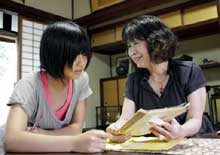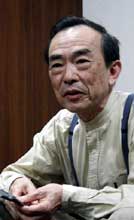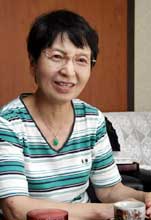Pictures by Hiroshima children return to the city
Forty-eight pictures and works of calligraphy made by former students of Honkawa Elementary School, located just 350 meters west of the hypocenter of the atomic bomb, will find their way home to the school this summer. In the aftermath of the war, these works were sent to a church in the United States in gratitude for the school supplies and sports equipment that the church had donated to the needy school. The pictures and writings will be displayed at the Honkawa Elementary School Peace Museum from August 1 to 9.
For this issue, we interviewed three of the former students who took part in the project about their lives at the time and the works they created. They now live in and around the city of Hiroshima.
They told us that the classrooms, with their broken windows and warped window frames, also lacked a sufficient number of chairs and so they were forced to sit on wooden boards placed between the chairs. They played kick-the-can and dodgeball and swam in the Honkawa River. Despite lacking resources, they were eager to live and rich in spirit, they recalled.
窶サ Click to enlarge each picture.
Depicting an ideal scene
Toshimi Ishida, 69, is a resident of Enomachi, Hiroshima, about 500 meters from the Hypocenter. He told us, "I have no memory of my picture." A note attached to the picture, though, says that the picture was drawn when Mr. Ishida was 8. It features a field of cherry trees in bloom. In reality, though, the field was full of rubble, not cherry blossoms. "I probably drew my ideal landscape," he said.
Mr. Ishida was 4 years old when the atomic bomb was dropped. He had been evacuated to Etajima Island, along with his mother and younger brother, prior to the blast. From the island he could see the mushroom cloud. His grandparents, though, remained in the city and were killed near the hypocenter. Ten days afterwards, his family returned to Hiroshima. He remembers seeing blue fires burning in the dark. When he was a child, he didn't have any special feelings toward the United States. "I was so young, I couldn't understand the link between the terrible atomic bomb and the United States. Both at home and at school, talking about such things was taboo," he recalls. Basically, he feels positive toward the United States now, but he still feels anger over the atomic bomb. "What the United States did was truly inhuman and can't be forgiven." Mr. Ishida looks forward to seeing his picture again, preserved in the United States for more than 60 years, and he wonders how he'll feel when he sees it. He hopes that the visitors to the exhibition will think about peace in relation to their families and others around them. (Shiori Kosaka, 15, and Saaya Teranishi, 14) |
Enjoying cherry blossoms safely
Toshiko Suemasa, 71, is a resident of Hiroshima. During the war, her family evacuated to the northern part of Takehara City, east of Hiroshima. In 1947, they returned to Hiroshima and she began attending Okou Elementary School, near her father's parents' house. The following year her family moved again to her mother's parents' house and she enrolled at Honkawa Elementary School. Ms. Suemasa encountered a number of relics of the A-bomb damage near the school. While swimming in the river, she struck a human bone with her foot. Another time, she saw something whirling like a firefly and found that it was the spontaneous combustion of a bone fragment. She said she was surprised, yet didn't feel scared or disgusted.
"How are we going to make it through another day?" she remembers constantly thinking. Her father died in the war and she lived with her mother and her two younger sisters. They didn't have enough food and earning enough income was hard without her father. She always worried that if her mother got ill, she wouldn't be able to provide for her sisters and their family would fall apart. For the exchange, she made a work of calligraphy, writing "Japan, the country of cherry blossoms," when she was in fifth grade. When she learned that her calligraphy had been preserved all this time, she felt "surprised and amazed that it was found after 60 years." Society today may be well-off, economically, but crime, including murder, now occurs more frequently. Ms. Suemasa hopes that "Japan becomes a country where people have bountiful hearts and can safely enjoy the cherry blossoms." (Yuumi Kimura, 14) |
| "A cargo boat and a flat-bottomed barge" by Shinji Asanuma, 12  |
"Outing to cherry blossoms" by Junko Hotta (now, Nanba), 8  |
"A girl wearing kimono" by Hiroko Nakajima (now, Tanabe Pauline), 12  |
"Children playing in a park" by Yoshiko Ito (now, Sasaki), 8  |
| 縲 | |||
| "River, sandbank, ships, and cherry blossoms" by Yoshie Fujii (now, Hiyoshi), 10  |
"Sports day" by Nobuko Tanaka, 9  |
"Sports day" by Kiomi Fujii (now, Kubota), 8  |
"A carp streamer is our friend" by Akihisa Yagi, 8  |
| 縲 | |||
| "Children playing on a swing and a slide" by Mieko Tanaka, 9  |
"A goldfish bowl" by Chihoko Nakagawa, 12  |
"A car" by Yoshihiro Nishimura, 11  |
"A bridge and a river" by Misako Shimomura (now, Tanabe), 10  |
| Photos of each picture are courtesy of All Souls Unitarian Church. Name and age of the artists were provided by the exhibition planning committee. |
Exhibition opens on August 1st, with 48 works of art
The exhibition entitled "Pictures from a Hiroshima Schoolyard" will be held from August 1 to 9 at the Honkawa Elementary School Peace Museum. It will feature 48 pictures and works of calligraphy returning to Hiroshima from across the ocean. They were sent from Honkawa Elementary School to All Souls Unitarian Church after the war to express their gratitude for a donation of school supplies and sports equipment that arrived from the church in 1947.
The idea for the exhibition was inspired by Shizumi Shigeto, a performing artist who lives in the United States. She encountered the pictures and calligraphy at the church in 2006 and began making a documentary film about the history behind them. Through her interactions with former students of Honkawa Elementary School, the decision was made to organize an exhibition.
The alumni association of Honkawa Elementary School organized a planning committee to prepare the exhibition. The committee has raised more than 500,000 yen from people in Japan and abroad to support the project.
Prior to the opening of the exhibition, a special event will be held at the school gymnasium on July 31 at 1:30 p.m. Former students who made the pictures and calligraphy and staff members of the U.S. church will hold a discussion and children from America will perform a Japanese dance. (Yuji Iguchi, 13)





